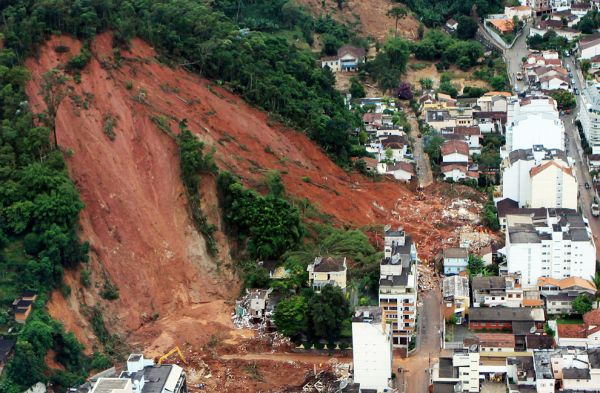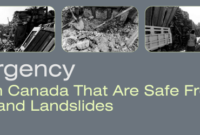Landslide Resistant Homes – Landslides can cause devastating damage, but with proper planning and construction techniques, it is possible to build homes that stand strong against these natural disasters.
By understanding the risks and implementing thoughtful design, homeowners can reduce the chances of landslide damage. Here are key strategies for creating a landslide-resistant home:
1. Choose the Right Location: Avoiding High-Risk Zones
The first step in preventing landslide damage is choosing a safe building site. Hillsides and mountainous areas can be highly prone to landslides, especially after heavy rains.
Before starting construction, conduct a thorough geological survey of the land. Avoid areas with a history of landslides or with steep slopes where erosion and soil movement are more likely.
Cause and Effect: Poor site selection often leads to instability in the foundation, which can cause the home to shift or collapse in the event of a landslide. Conversely, building on stable ground reduces the risk of soil movement and damage.
2. Effective Drainage Systems: Managing Water Flow
Water is a major trigger for landslides. Excess water weakens soil structure, causing it to slide down slopes. Implementing an effective drainage system around the house is crucial for controlling water flow.
Techniques to Implement:
- French drains: A gravel-filled trench with a perforated pipe that redirects water away from the building.
- Rain gutters and downspouts: These direct rainwater away from the foundation, preventing the ground from becoming saturated.
- Terracing: Build stepped levels into the hillside to slow down water flow and reduce soil erosion.
Cause and Effect: Without proper drainage, water can accumulate around the foundation, increasing the risk of soil movement. Good drainage systems keep the soil dry and firm, reducing landslide risk.
Read also:
1. Designing Flood-Safe Houses and Necessary Preparations
2. Building a Hurricane-Resistant Home: Key Features and Considerations
3. How to Prepare for a Heatwave Disaster
3. Reinforce the Foundation: Strengthening the Base
A strong, well-anchored foundation is essential in landslide-prone areas. Foundations should be reinforced with materials that can resist soil movement and shifting.
Techniques to Implement:
- Deep Pile Foundations: Piles are long, sturdy columns driven deep into the ground to anchor the house into stable soil layers.
- Retaining Walls: Build retaining walls to hold back soil and prevent it from sliding downhill.
- Anchor Systems: Use ground anchors to tie the house to bedrock or other stable strata beneath the surface.
Cause and Effect: A weak foundation is more likely to crack or break under the pressure of moving soil. Reinforced foundations, on the other hand, provide additional stability, helping the house remain intact during a landslide.
4. Vegetation and Landscaping: Natural Soil Retention
Vegetation plays a significant role in preventing landslides. Trees, shrubs, and grasses help bind the soil with their roots, reducing erosion and keeping the ground stable.
Best Practices:
- Plant deep-rooted trees and shrubs around the property to help hold the soil in place.
- Use groundcover plants to reduce surface erosion.
- Avoid removing large areas of vegetation during construction, as this can increase soil instability.
Cause and Effect: Clearing vegetation destabilizes the soil, making it more susceptible to sliding. Keeping vegetation intact or adding plants can help secure the soil and prevent landslides.
5. Slope Stabilization Techniques: Reducing the Risk of Movement
For homes built on or near slopes, stabilizing the slope itself is crucial. This can be achieved through a combination of natural and engineered methods.
Techniques to Implement:
- Grading: Reshape the slope to reduce its steepness and lower the risk of soil movement.
- Geotextiles: Use geotextile fabrics to reinforce the soil and prevent erosion.
- Rock Bolts and Mesh: Install rock bolts or wire mesh to hold rocky slopes in place and reduce the chance of landslides.
Cause and Effect: Steep, unstable slopes are a major cause of landslides. Stabilizing the slope reduces the risk of soil sliding, protecting the home from damage – Landslide Resistant Homes.
6. Ongoing Monitoring and Maintenance: Stay Vigilant
Building a landslide-resistant home isn’t just about construction—regular monitoring and maintenance are critical. Over time, soil movement, water accumulation, and other environmental factors can affect the stability of your property.
Tips for Homeowners:
- Inspect drainage systems regularly to ensure they are working properly.
- Watch for early warning signs like cracks in walls, sinking foundations, or sudden shifts in the landscape.
- Take immediate action if you notice signs of soil movement or increased erosion.
Cause and Effect: Neglecting maintenance can lead to unnoticed problems that escalate into major damage. Regular inspections and repairs help catch issues early, preventing landslides from threatening your home.
Conclusion
By incorporating these strategies, homeowners can greatly reduce the risk of landslides and protect their properties.
From careful site selection and effective drainage systems to reinforced foundations and stable slopes, each step plays a crucial role in creating a landslide-resistant home.
Investing in these measures not only ensures the safety of the home but also provides peace of mind in regions prone to this natural disaster – Landslide Resistant Homes.
Alabama, Alaska, Arizona, Arkansas, California, Colorado, Connecticut,
Delaware, Florida, Georgia, Hawaii, Idaho, Illinois, Indiana, Iowa, Kansas, Kentucky, Louisiana, Maine, Maryland, Massachusetts, Michigan, Minnesota, Mississippi, Missouri, Montana, Nebraska, Nevada, New Hampshire, New Jersey, New Mexico, New York, North Carolina, North Dakota, Ohio, Oklahoma, Oregon, Pennsylvania, Rhode Island, South Carolina, South Dakota, Tennessee, Texas, Utah, Vermont, Virginia, Washington, West Virginia, Wisconsin, Wyoming,
Afghanistan,Albania,Algeria,Andorra,Angola,Antigua and Barbuda,Argentina,Armenia,Australia,Austria,Azerbaijan,The Bahamas,Bahrain,Bangladesh,Barbados,Belarus,Belgium,Belize,Benin,Bhutan,Bolivia,Bosnia and Herzegovina,Botswana,Brazil,Brunei,Bulgaria,Burkina Faso,Burundi,Cabo Verde,Cambodia,Cameroon,Canada,Central African Republic,Chad,Chile,China,Colombia,Comoros,Congo,Democratic Republic of the Congo,Republic of the Costa Rica,Côte d’Ivoire,Croatia,Cuba,Cyprus,Czech Republic,Denmark,Djibouti,Dominica,Dominican Republic,East Timor (Timor-Leste),Ecuador,Egypt,El Salvador,Equatorial Guinea,Eritrea,Estonia,Eswatini,Ethiopia,Fiji,Finland,France,Gabon,The Gambia,Georgia,Germany,Ghana,Greece,Grenada,Guatemala,Guinea,Guinea-Bissau,Guyana,Haiti,Honduras,Hungary,Iceland,India,Indonesia,Iran,Iraq,Ireland,Israel,Italy,Jamaica,Japan,Jordan,Kazakhstan,Kenya,Kiribati,Korea North,Korea South,Kosovo,Kuwait,Kyrgyzstan,Laos,Latvia,Lebanon,Lesotho,Liberia,
Libya,Liechtenstein,Lithuania,Luxembourg,Madagascar,Malawi,Malaysia,Maldives,Mali,Malta,Marshall Islands,
Mauritania,Mauritius,Mexico,Micronesia Federated States of Moldova,Monaco,Mongolia,Montenegro,Morocco,
Mozambique,Myanmar (Burma),Namibia,Nauru,Nepal,Netherlands,New Zealand,Nicaragua,Niger,Nigeria,North Macedonia,Norway,Oman,Pakistan,Palau,Panama,Papua New Guinea,Paraguay,Peru,Philippines,Poland,Portugal,Qatar,Romania,Russia,Rwanda,Saint Kitts and Nevis,Saint Lucia,Saint Vincent and the Grenadines,Samoa,San Marino,Sao Tome and Principe,Saudi Arabia,
Senegal,Serbia,Seychelles,Sierra Leone,Singapore,Slovakia,Slovenia,Solomon Islands,Somalia,South Africa,Spain,Sri Lanka,Sudan,Sudan South,Suriname,Sweden,Switzerland,Syria,Taiwan,Tajikistan,Tanzania,Thailand,Togo,Tonga,Trinidad and Tobago,Tunisia,Turkey,Turkmenistan,Tuvalu,Uganda,Ukraine,United Arab Emirates,United Kingdom,United States,Uruguay,Uzbekistan,Vanuatu,Vatican City,Venezuela,Vietnam,Yemen,Zambia,Zimbabwe,






